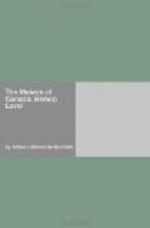The labour demanded at this period by pastoral visits in a diocese so extended may readily be imagined. Besides the towns of Quebec, Montreal and Three Rivers, in which was centralized the general activity, there were then several Christian villages, those of Lorette, Ste. Foy, Sillery, the village of La Montagne at Montreal, of the Sault St. Louis, and of the Prairie de la Madeleine. Far from avoiding these trips, Mgr. de Laval took pleasure in visiting all the cabins of the savages, one after another, spreading the good Word, consoling the afflicted, and himself administering the sacraments of the Church to those who wished to receive them.
Father Dablon gives us in these terms the narrative of the visit of the bishop to the Prairie de la Madeleine in 1676. “This man,” says he, speaking of the prelate, “this man, great by birth and still greater by his virtues, which have been quite recently the admiration of all France, and which on his last voyage to Europe justly acquired for him the esteem and the approval of the king; this great man, making the rounds of his diocese, was conveyed in a little bark canoe by two peasants, exposed to all the inclemencies of the climate, without other retinue than a single ecclesiastic, and without carrying anything but a wooden cross and the ornaments absolutely necessary to a bishop of gold, according to the expression of authors in speaking of the first prelates of Christianity.”
[The expedition of Dollard is related in detail by Dollier de Casson, and by Mother Mary of the Incarnation in her letters. The Abbe de Belmont gives a further account of the episode in his history. The Jesuit Relations place the scene of the affair at the Chaudiere Falls. The sceptically-minded are referred to Kingsford’s History of Canada, vol. I., p. 261, where a less romantic view of the affair is taken.]—Editors’ Note on the Dollard Episode.




